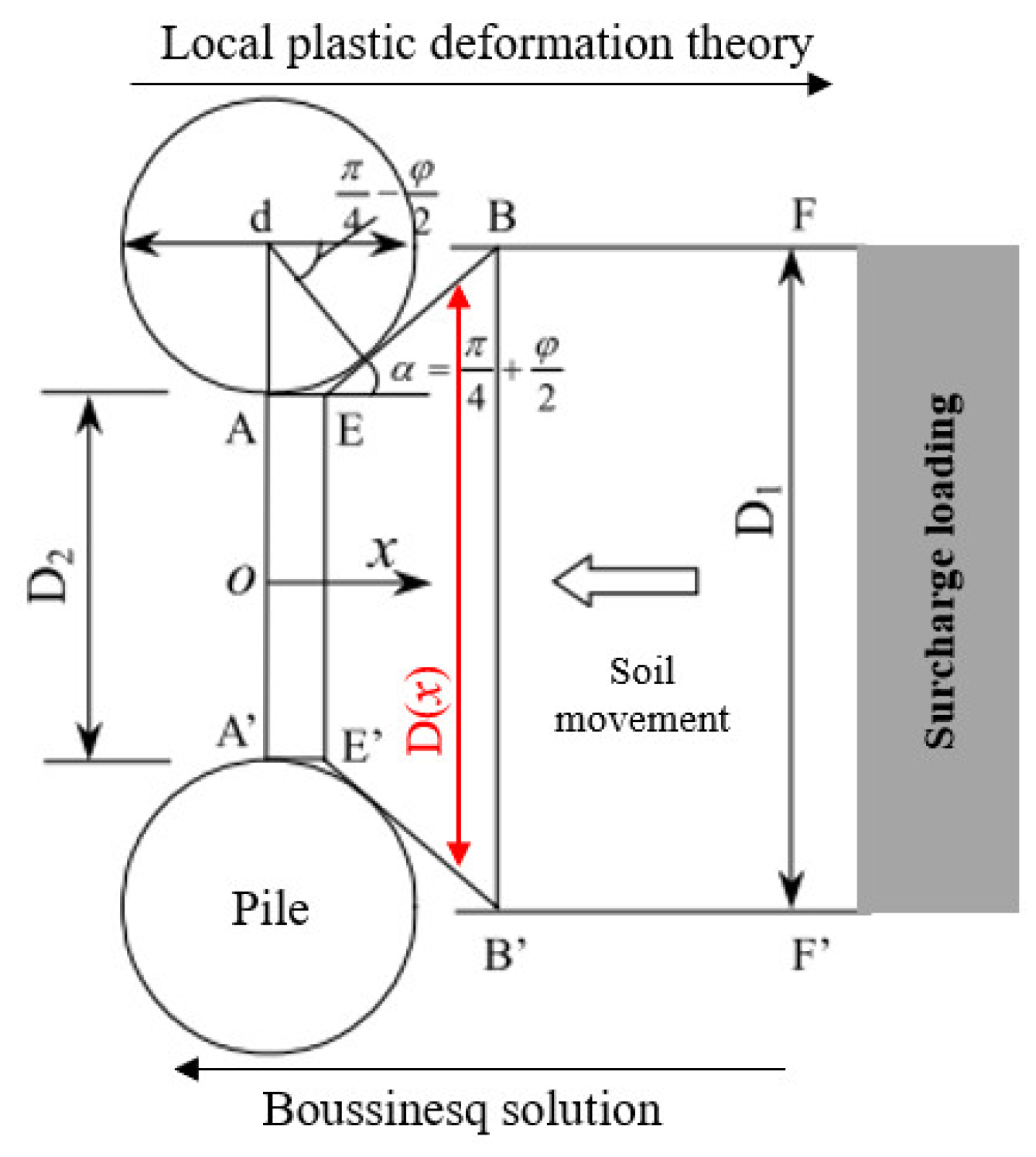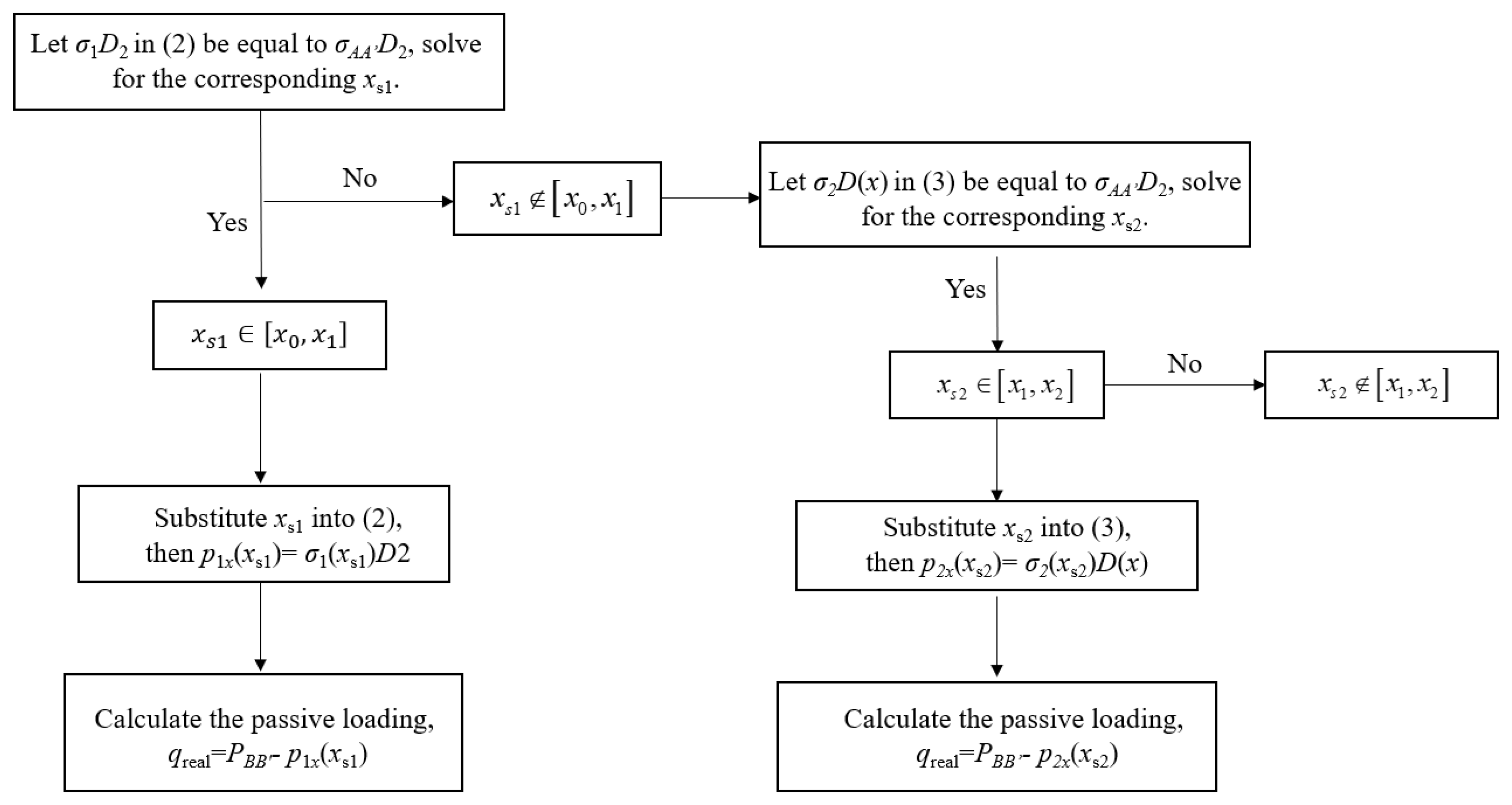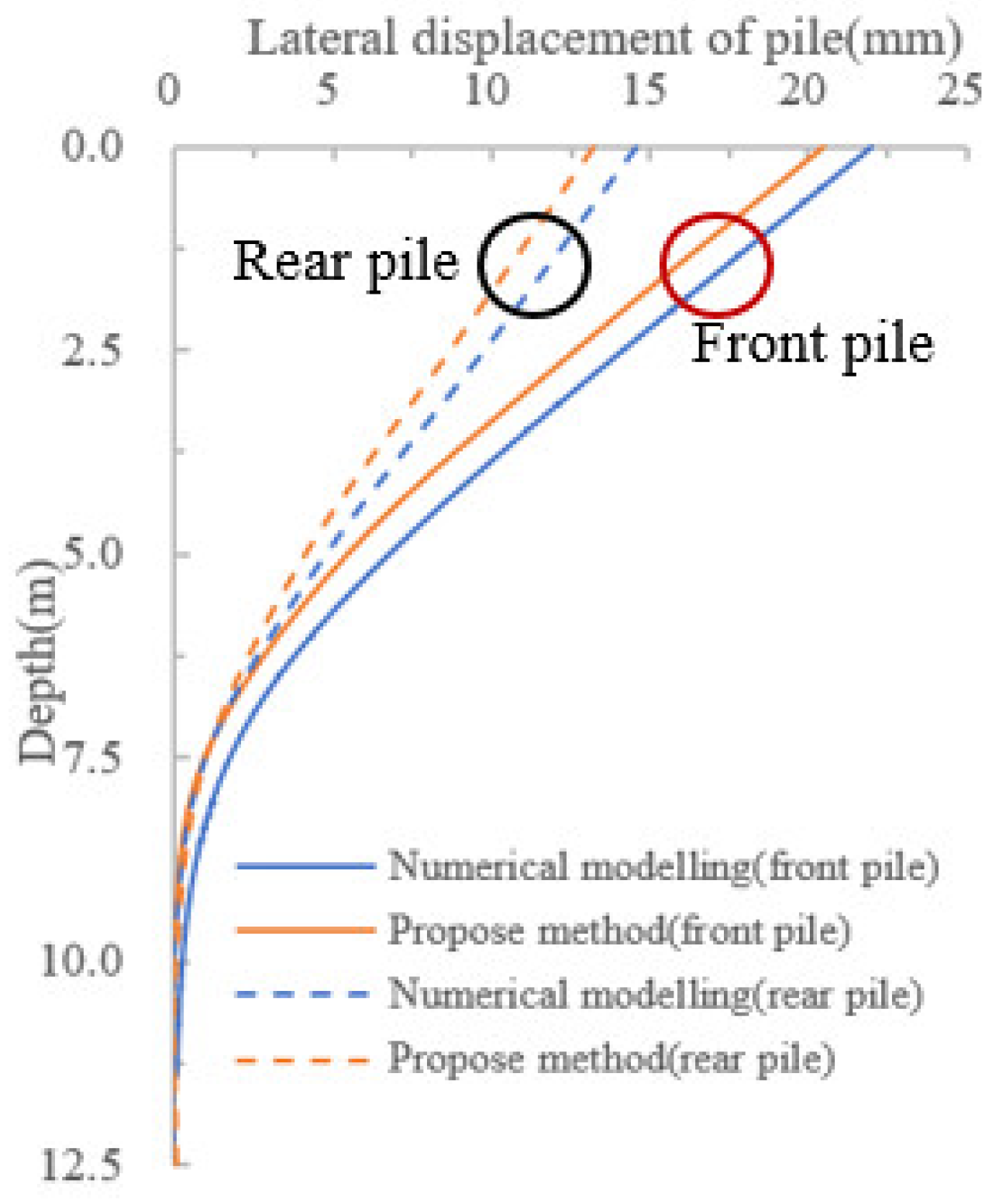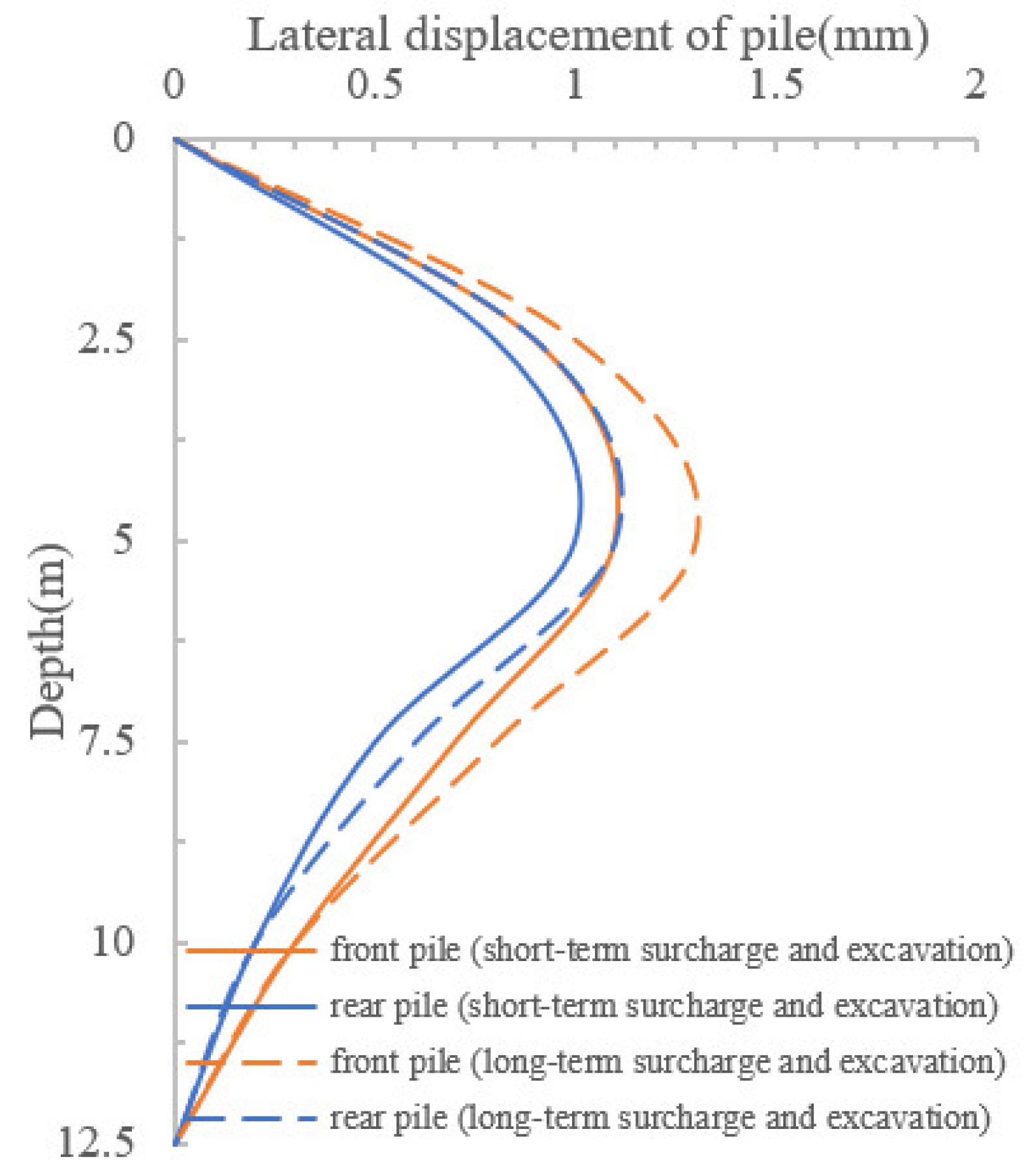Investigation of Passive Pile Groups’ Responses Induced by Combined Surcharge-Induced and Excavation-Induced Horizontal Soil Loading
Abstract
:1. Introduction
2. Analysis Method
2.1. The Passive Load of Pile Groups Due to Surcharge-Induced Horizontal Soil Loading
2.2. The Total Additional Lateral Forces of Pile Groups Caused by Excavation-Induced Horizontal Soil Loading
2.3. Two-Parameter Foundation Model
3. Validation
3.1. The Centrifuge Model Test of Ellis et al.
3.2. The Pile Group Centrifuge Model Test of Ong et al.
3.3. Numerical Modelling
4. Parametric Analysis and Discussion
4.1. Influence of Free-Head Pile Groups under Combined Excavation and Staged Surcharge Loading
4.2. Influence of Capped-Head Pile Group Constraints
5. Conclusions
- (1)
- The proposal of a two-stage method for the response of passive pile groups caused by combined surcharge-induced and excavation-induced horizontal soil loading. Firstly, the passive load of pile foundations resulting from surcharge-induced horizontal soil loading was determined using the improved formula of Boussinesq and the theory of local plastic deformation. The additional horizontal force exerted on the pile axis subjected to excavation-induced horizontal soil loading was also taken into account using the Mindlin solution. Furthermore, the shielding effect between pile groups was also proposed to analyze the response of a laterally loaded pile group due to excavation unloading. Secondly, according to the Pasternak foundation model of soil–pile interaction, the equilibrium differential equations were solved using the finite difference method.
- (2)
- The rationality of the proposed method for the response of passive pile groups was verified by two published centrifuge tests under the surcharge-induced and excavation-induced horizontal soil loading, respectively, and also validated by numerical modeling subjected to combined loading-induced and unloading-induced horizontal soil loading.
- (3)
- A series of parametric analyses for responses of pile groups subjected to combined loading-induced and unloading-induced horizontal soil loading was conducted, including the surcharge procedure (direct or staged) and different constraints on the pile head (free-head pile groups, capped-head pile groups with free-fixed end, and capped-head pile groups with fully fixed ends).
- (4)
- The results demonstrate that the capped-head pile groups can provide greater restraint compared to the free-head for the lateral displacement of pile groups. The front pile experienced greater forces than the rear due to the smaller soil pressure on the rear pile. Additionally, increasing the horizontal stiffness of the capped-head pile groups with fully fixed ends can significantly decrease the lateral displacement of the pile groups.
- (5)
- For further research, the response of passive pile groups under the combined action of pile loading and the excavation of foundation pits, the time-dependent aspects of passive pile groups, and environmental factors will require future research.
Author Contributions
Funding
Data Availability Statement
Conflicts of Interest
References
- Yang, M.; Shangguan, S.; Li, W.; Zhu, B. Numerical Study of Consolidation Effect on the Response of Passive Piles Adjacent to Surcharge Load. Int. J. Geomech. 2017, 17, 04017093. [Google Scholar] [CrossRef]
- Wang, W.D.; Ng, C.W.; Hong, Y.; Hu, Y.; Li, Q. Forensic study on the collapse of a high-rise building in Shanghai: 3D centrifuge and numerical modelling. J. Géotechnique 2019, 69, 847–862. [Google Scholar] [CrossRef]
- Tan, Y.; Jiang, W.Z.; Rui, H.S.; Lu, Y.; Wang, D.L. Forensic Geotechnical Analyses on the 2009 Building-Overturning Accident in Shanghai, China: Beyond Common Recognitions. J. Geotech. Geoenviron. Eng. 2020, 146, 05020005. [Google Scholar] [CrossRef]
- Li, Z.C.; Liang, Z.R. Calculation model and numerical analysis of passive piles subjected to adjacent surcharge loads. Chin. J. Geotech. Eng. 2010, 32, 128–134. [Google Scholar]
- Poulos, H.G.; Chen, L.T. Pile Response Due to Excavation-Induced Horizontal soil loading. J. Geotech. Geoenviron. Eng. 1997, 123, 94–99. [Google Scholar] [CrossRef]
- Liang, F.Y.; Yu, F.; Li, J.P. Analysis of bearing capacity of a single pile under adjacent building subjected to horizontal soil loadings. J. Rock Soil Mech. 2010, 31, 449–454. [Google Scholar]
- Liang, F.; Yu, F.; Han, J. A simplified analytical method for response of an axially loaded pile group subjected to horizontal soil loading. KSCE J. Civ. Eng. 2013, 17, 368–376. [Google Scholar] [CrossRef]
- Yang, M.; Zhu, B.T. Finite Element Method Used in Modeling Horizontal soil loading due to Surcharge Loads and Its Effect on Adjacent Piles. J. Tongji Univ. 2003, 7, 772–777. [Google Scholar]
- Feng, C.M.; Mu, L.L.; Sun, Z.W.; Wang, Y.Z. Two-stage analysis of responses of bridge pile foundations to adjacent surcharge. J. Rock Soil Mech. 2014, 35, 528–534. [Google Scholar]
- Zhu, M.X. Research on Bearing Mechanism of Passive Pile under Combined Loads. Ph.D. Thesis, Southeast University, Nanjing, China, 2016. [Google Scholar]
- Zheng, G.; Yan, Z.X.; Lei, H.Y.; Lei, Y. Field observation and finite element numerical simulation analysis of effect on adjacent piles due to excavation. Chin. J. Geotech. Eng. 2007, 29, 638–643. [Google Scholar]
- Li, Z.W.; Zheng, G. Finite element analysis of response of building with different stiffnesses adjacent to excavation. J. Rock Soil Mech. 2013, 34, 1807–1814. [Google Scholar]
- Finno, R.J.; Lawrence, S.A.; Allawh, N.F.; Harahap, I.S. Analysis of Performance of Pile Groups Adjacent to Deep Excavation. J. Geotech. Eng. 1991, 117, 934–955. [Google Scholar] [CrossRef]
- Yang, T.; Tong, L.Y.; Pan, H.S. Lateral force and displacement of passive pile under surcharge loading and excavation of foundation pit. J. Southeast Univ. (Nat. Sci. Ed.) 2021, 51, 449–455. [Google Scholar]
- Mindlin, R.D. Force at a Point in the Interior of a Semi-Infinite Solid. Physics 1936, 7, 195–202. [Google Scholar] [CrossRef]
- Wei, G.; Zhao, C.L. Calculation method of additional load of adjacent metro tunnels due to foundation pit excavation. J. Chin. J. Rock Mech. Eng. 2016, 35, 3408–3417. [Google Scholar]
- Huang, M.S.; Zhang, C.R.; Li, Z. A simplified analysis method for the influence of tunnelling on grouped piles. J. Tunn. Undergr. Space Technol. 2009, 24, 410–422. [Google Scholar] [CrossRef]
- Ong, D.E.L.; Leung, C.E.; Chow, Y.K. Behavior of Pile Groups Subject to Excavation-Induced Soil Movement in Very Soft Clay. J. Geotech. Geoenviron. Eng. 2009, 135, 1462–1474. [Google Scholar] [CrossRef]
- Li, T.; Yang, M.; Chen, X. A Simplified Analytical Method for the Deformation of Pile Foundations Induced by Adjacent Excavation in Soft Clay. Buildings 2023, 13, 1919. [Google Scholar] [CrossRef]
- Pasternak, P.L. On a New Method of an Elastic Foundation by Means of Two Foundation Constants; Gosudarstvennoe Izdatelstvo Literaturi Po Stroitelstuve I Arkhitekture: Moscow, Russia, 1954. [Google Scholar]
- Vesic, A.B. Bending of beams resting on isotropic elastic solid. J. Eng. Mech. Div. 1961, 87, 35–53. [Google Scholar] [CrossRef]
- Goh, A.T.C.; Teh, C.I.; Wong, K.S. Analysis of piles subjected to embankment induced lateral soil movements. J. Geotech. Geoenviron. Eng. 1997, 123, 792–801. [Google Scholar] [CrossRef]
- Tanahashi, H. Formulas for an Infinitely Long Bernoulli-Euler Beam on the Pasternak Model. Soils Found. 2004, 44, 109–118. [Google Scholar] [CrossRef]
- Shi, J.; Ng, C.W.W.; Chen, Y. Three-dimensional numerical parametric study of the influence of basement excavation on existing tunnel. Comput. Geotech. 2015, 63, 146–158. [Google Scholar] [CrossRef]
- Ellis, E.A.; Springman, S.M. Full-height piled bridge abutments constructed on soft clay. J. Géotechnique 2001, 51, 3–14. [Google Scholar] [CrossRef]
- PLAXIS. PLAXIS Material Models Manual; PLAXIS: Delft, The Netherlands, 2016. [Google Scholar]











| Structure Type | Young’s Modulus/MPa | Poisson’s Ratio | Unit Weight/kN·m3 | c/kPa | φ/(°) |
|---|---|---|---|---|---|
| Upper clay | 150 Cu * | 0.38 | 16.6 | 2 | 23 |
| Sandy | 6 z | 0.31 | 20 | 1 | 43 |
| Retaining wall | 20,400 | 0.28 | 27 | - | - |
| Pile | 40,000 | 0.28 | 27 | - | - |
Disclaimer/Publisher’s Note: The statements, opinions and data contained in all publications are solely those of the individual author(s) and contributor(s) and not of MDPI and/or the editor(s). MDPI and/or the editor(s) disclaim responsibility for any injury to people or property resulting from any ideas, methods, instructions or products referred to in the content. |
© 2023 by the authors. Licensee MDPI, Basel, Switzerland. This article is an open access article distributed under the terms and conditions of the Creative Commons Attribution (CC BY) license (https://creativecommons.org/licenses/by/4.0/).
Share and Cite
Li, T.; Yang, M. Investigation of Passive Pile Groups’ Responses Induced by Combined Surcharge-Induced and Excavation-Induced Horizontal Soil Loading. Buildings 2023, 13, 2775. https://doi.org/10.3390/buildings13112775
Li T, Yang M. Investigation of Passive Pile Groups’ Responses Induced by Combined Surcharge-Induced and Excavation-Induced Horizontal Soil Loading. Buildings. 2023; 13(11):2775. https://doi.org/10.3390/buildings13112775
Chicago/Turabian StyleLi, Tingting, and Min Yang. 2023. "Investigation of Passive Pile Groups’ Responses Induced by Combined Surcharge-Induced and Excavation-Induced Horizontal Soil Loading" Buildings 13, no. 11: 2775. https://doi.org/10.3390/buildings13112775





